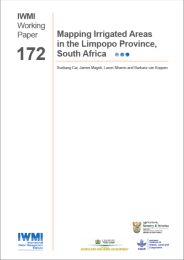Mapping irrigated areas in the Limpopo Province, South Africa
 This research report chronicles the evolution of thinking on water productivity in the research agenda of IWMI and in the broader irrigation literature over the past 20 years. It describes the origins of the concept and the methodological developments, its operationalization through applied research, and some lessons learned over the two decades of research. This report further highlights how a focus on agricultural water productivity has brought greater attention to critical water scarcity issues, and the role of agricultural water management in supporting broader development objectives such as increasing agricultural production, reducing agricultural water use, raising farm-level incomes, and alleviating poverty and inequity. Yet, reliance on a single-factor productivity metric, such as agricultural water productivity defined as “crop per drop,” in multi-factor and multi-output production processes can mask the complexity of agricultural systems as well as the trade-offs required to achieve desired outcomes. The findings from this retrospective underscore the limitations of single-factor productivity metrics while also highlighting opportunities to support more comprehensive approaches to address water scarcity concerns and, ultimately, achieve the broader development objectives.
This research report chronicles the evolution of thinking on water productivity in the research agenda of IWMI and in the broader irrigation literature over the past 20 years. It describes the origins of the concept and the methodological developments, its operationalization through applied research, and some lessons learned over the two decades of research. This report further highlights how a focus on agricultural water productivity has brought greater attention to critical water scarcity issues, and the role of agricultural water management in supporting broader development objectives such as increasing agricultural production, reducing agricultural water use, raising farm-level incomes, and alleviating poverty and inequity. Yet, reliance on a single-factor productivity metric, such as agricultural water productivity defined as “crop per drop,” in multi-factor and multi-output production processes can mask the complexity of agricultural systems as well as the trade-offs required to achieve desired outcomes. The findings from this retrospective underscore the limitations of single-factor productivity metrics while also highlighting opportunities to support more comprehensive approaches to address water scarcity concerns and, ultimately, achieve the broader development objectives.
